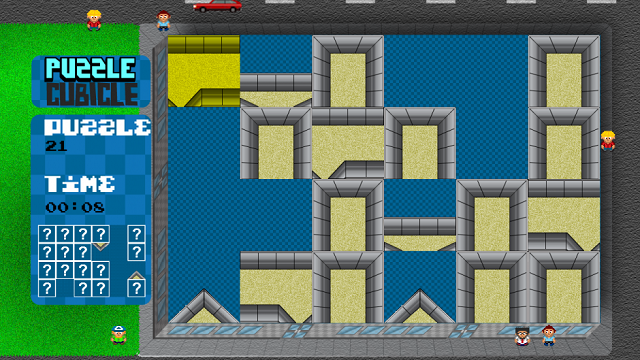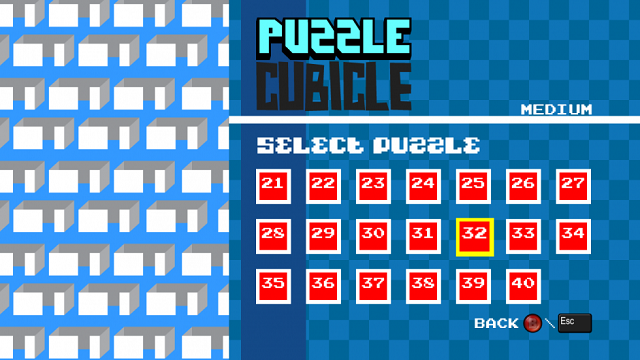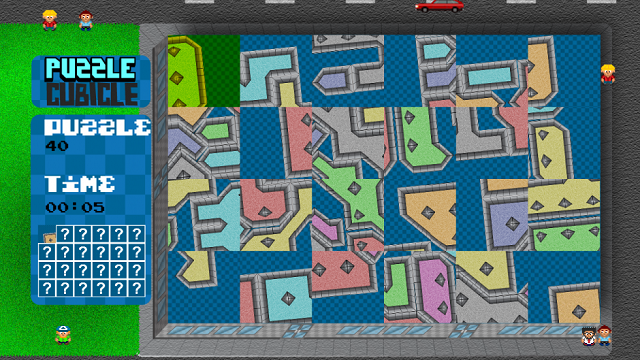If you have a simple, straightforward game with little frills, everything needs to be tight and working properly. Think Tetris, if you need an example. In Tetris, all you have to do is arrange blocks into lines as they come down at you with increasing speed. Imagine if that game had never varied up the speed of the blocks coming down, or if they’d forgotten to put in the ‘T’ shaped block, and you can see how very small details can completely wreck a good puzzle game. Unfortunately, Puzzle Cubicle is a game that is bogged down with small problems that ruin the experience.
Your job is to rearrange a set of pieces into walled-in ‘cubicles’ of specific colors within a provided grid. Each puzzle only has one set solution, so your job is to see just how quickly you can find it. It’s a pretty simple task, but it’s made more difficult by a few bad decisions. For starters, you have to arrange the blocks in the exact order and position that the game wants you to. Now, the game has a mini-map to one side that shows you where pieces should fit on the grid you’re working on, so you know that every piece should fit somewhere within those specific places.
The drag is that on many occasions I had more than enough room to build the puzzle in the wrong position, and then had to move the whole thing over to where the game would accept my solution. Even though I had the right answer completed on the board, the game wouldn’t accept until it was where the game demanded it had to go. It was a nuisance each time, but hardly game breaking.
There are also pieces that are specific to certain positions on the grid, and absolutely have to be there for the puzzle to be completed. Instead of the game placing them there off the get-go, I had to reference that mini-map in the lower left corner and position them myself. Even on my huge television, that mini-map is annoyingly small, and often I’d find that I put the wrong piece in place; or that I’d put it a row down or up from where I was supposed to. This lead to more rearranging, and instead of doing a puzzle, I’d have to work on set-up for a few minutes at the start of every round. Again, I was annoyed, but I kept going.
Both of these complaints could have been fixed by having the game give you a puzzle-specific grid with certain pieces already in place. That way I’d already know what structure I had to build into, and wouldn’t have to spend time setting up the board. As it stands, I have to spend a good two or three minutes (And striving for a decent time is really the only competitive aspect of this game) putting the game together for myself, as if I was playing a board game on my floor. There’s no reason I should have to do this stuff.
There are lots of other minor problems that continue to compound this game’s woes. As I said before, some of the cubicles need to be built by matching the colors within the walls. That seems simple until you pick up a piece to move, and the game overwrites its color with another one so you can know you picked it up. Now, unless you memorized what color the piece was before you picked it up, you’re probably going to have to put it back down and look at it again so you can remember what color you’re looking for. That might not have been that bad, but some pieces have multiple colors on them, so you’re constantly picking up and dropping the same piece while you try to get it oriented correctly. It just bogs the game down, and drove me up the wall.
For whatever reason, the game also boots you back to the main menu every time you beat a puzzle. You’re prompted to hit ‘B’ after beating a puzzle, which kicks you most of the way out of the game instead of moving you on to the next puzzle. This one was a little baffling, as I couldn’t see a single reason why they wouldn’t want me to move on to the next puzzle immediately, since that was what I wanted to do when I beat one. I can’t even begin to guess how it got set up this way.
Those problems are hardly the worst I’d had, though. On one level, the game just didn’t accept my solution; simple as that. The game touts that there’s only one solution to every puzzle, and I’d found one. I double and triple checked to make sure that every wall had linked up, and I couldn’t see a flaw in what I’d done. Everything was in the right place, in the correct squares, and the mandatory pieces were all where they should have been. After several minutes of glaring at the screen looking for where I’d gone wrong, I gave up and shut off the game.
There is no reason why the game shouldn’t have accepted my answer. I had done everything the game’s confusing rule screen had asked of me (Reading the rules actually slowed down my ability to figure out what I was supposed to do. Figure that out), but the game didn’t like my answer because it wasn’t the ones the developers had picked out. The game was looking for certain blocks set at specific orientations rather than whether the colors and walls matched up, creating an infuriating flaw in quite a few of the puzzles. It did mean that there was only one acceptable solution, but that you could find others that should work but the game won’t accept as answers. It made the game far more frustrating than it needed to be.
The music and presentation don’t do it any favors, either. Given it was called Puzzle Cubicle, I expected that the pieces would look like cubicles in an office or something. Now, that might be asking too much of a game that cost $1, or might have been something that would have made it harder to put the puzzle together, but they could have done something to make the game more visually pleasing. Having a couple of 8-bit office workers wandering around the outside of the work area doesn’t cut it. The music was also bland and extremely repetitive, to the point where I just shut it off and listened to some Mega Ran. It’s funny, because the music, while showing no inspiration or effort whatsoever, is one of the things the game touts as a feature.
I wanted to like Puzzle Cubicle, but the people at its helm made that as difficult as possible through lazy programming. Instead of putting together a good, challenging puzzle game with multiple possible solutions, they programmed one acceptable solution and called it a day. They also made many other bizarre choices that made the game a little bit easier for them to program, like forcing the player to set up the proper grid with the mini-map, instead of setting everything up from the start. Nothing in this game feels like the programmers put in anything more than the most basic effort.
That’s a really big problem for several reasons. For one, the indie market is glutted with slapdash games put together by people hoping to make a quick buck. This game does have an interesting take on jigsaw puzzles, but there is nothing in its presentation that makes it stand out from the crowd of junk. It’s bland and filled with problems, and with the indie market as crowded as it is, that’s not making it easy for people to buy your game. It also doesn’t help that there are tons of free online jigsaw puzzle style games, so again, Puzzle Cubicle needed to offer something they didn’t have in order to stay competitive.
As it stands, Puzzle Cubicle is an interesting but broken game; and one I can’t recommend over the hundreds of free versions of it available online. While Puzzle Cubicle may offer an interesting take on jigsaw games, nothing in its presentation or programming is going to set it apart from versions you could get for nothing. You’ll still have some fun for the dollar you spend on it, but when you can get better puzzle games for free, why would you bother?









